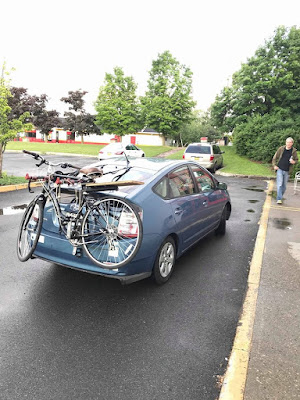Even the dismal road has its blessings.
 |
| The open road in Minnesota. Photo courtesy Douglas Perot |
“You should have been a cross-country truck driver who paints,” Mary Byrom told me. This week, that’s exactly what I am.
I didn’t stop to paint in the Badlands on Wednesday. It was a crying shame, for they were beautiful and the weather was clement. But the sky told me the weather was changing faster than I’d anticipated. “I have to get ahead of this storm,” I told my husband, and gunned it.
Our original plan was to cut down to I-80 and stop in Iowa. According to Google Maps, that would shave twenty minutes off my trip. “I don’t believe it,” I said, and stayed on I-90. Anyways, I kind of liked the idea of driving 2000 miles on the same road. We coasted into Albert Lea, MN in the late hours.
 |
| The Badlands are vast and fascinating. Photo courtesy Dwight Perot. |
My dog and I did a quick tour around the shrubberies but neither of us wanted to prolong the Minnesota winter experience. It was ferociously windy and snowing steadily. That bad weather I’d wanted in Thermopolis had caught up with me.
The next morning, I borrowed a shovel to clear out the bed of the truck. We wrapped our stuff in contractor bags and eased back on to the highway. I have a niece who lives in Minnesota on purpose. She tells me that the temperature tomorrow will drop to -15° F. It’s hard for me to see the attraction when the wind is howling and the mercury is dropping, but she too is from Buffalo.
I amuse myself on long-distance drives by doing arithmetic. This trip, I calculated just how far behind we were dropping behind. After I got to -5 hours, I decided my game was too depressing. It was still better than talk radio, however.
 |
| My truck will get a tonneau cover as soon as I swap the tailgate back to the original. |
My son is with me. He’s a responsible driver but he’s young. There was no way I was letting him play bumper cars in a blizzard.
Travel generally gets cumbersome east of the Mississippi anyway. There are tolls (which you can’t pay with cash right now) and the clean, efficient rest stops of the west have been replaced with travel plazas where you must run a gauntlet of merchandise in order to freshen up. And, of course, there’s much more traffic.
At a rest stop, I caught a message from Jane Chapin. A 40-car pileup had paralyzed I-80 eastbound in Iowa. It’s days like this that reaffirm my belief in a providential God. Had I not ignored my itinerary, I’d have been on that road.
That’s not to say my prayers are always answered. Yesterday an old friend died of COVID despite my earnest entreaties on her behalf. There has been no respite in the onslaught of COVID recently; another friend lost her husband to it last week. I was already struggling with those back-to-back deaths when I learned that still another friend has been diagnosed with a very serious cancer.
I realize there’s no equivalence in these things; Kathy’s death is a cataclysm, whereas a truck is just a truck. But still, I’d lose all hope if it weren’t for the occasional touch of heaven on my shoulder. When the stakes are high enough, we’re all with that guy in the Bible who cried, “I do believe! Help me overcome my unbelief!”
I’m going right through Buffalo but there will be no public funeral. That’s actually a relief since it takes the decision out of my hands. I’ve been all over the country; I ought not risk bringing more COVID to my friends and family. My uncle’s funeral back in March was private for just that reason. In this plague year, the obsequies are gone but the grief remains.













